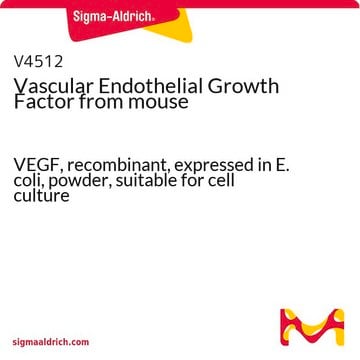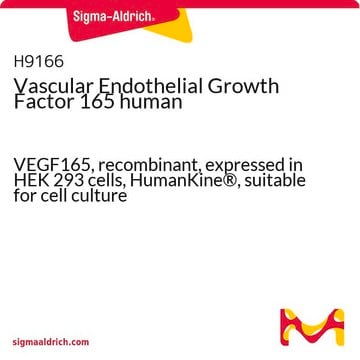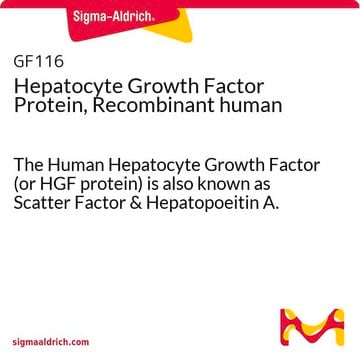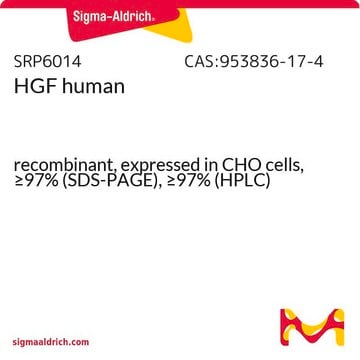01-185
VEGF Protein, Human recombinant
The human recombinant VEGF Protein is available in a 10 µg format.
Synonym(s):
VEGF Growth Factor
About This Item
Recommended Products
biological source
human
Quality Level
recombinant
expressed in baculovirus infected Sf9 cells
form
liquid
manufacturer/tradename
Upstate®
technique(s)
cell culture | mammalian: suitable
input
sample type neural stem cell(s)
sample type hematopoietic stem cell(s)
sample type mesenchymal stem cell(s)
NCBI accession no.
UniProt accession no.
shipped in
dry ice
Gene Information
human ... VEGFA(7422)
General description
Application
1. Prior to use in this assay, maintain HUVE cells in F-12K medium supplemented with 10% (v/v) FBS, 1% penicillin-streptomycin-glutamine, 0.1 mg/ml heparin and 0.05 mg/ml endothelial cell growth supplement (ECGS).
2. For assay of VEGF, subculture HUVE cells into a 96-well plate at a density of 4,000 cells per well in the growth medium over night.
3. Add VEGF to a final concentration range of 0.2, 0.4, 0.8, 1.6, 3.2, 6.2, 12.5, 25 and 50ng/ml. Add VEGF diluent to one set of wells as the negative control.
4. Four days later, add 20ul of Promega Substrate Cell Titer 96 Aqueous One Solution Reagent to each well.
5. Incubate at 37C for 2 hrs and read at OD 490nm.
Quality
Cell Proliferation Assay: The biological activity of this lot of VEGF was determined by its mitogenic activity on human umbilical vein endothelial cells (HUVEC) with an ED50 of about 1.0 ng/mL. Results may vary depending on the cell line used. VEGF will also stimulate endothelial cells from other species.
Physical form
Storage and Stability
This product is acid stable. Dilute in either 0.1% TFA or 4mM HCl, containing 25ug BSA per ug VEGF to maintain stability. Reducing reagents (such as dithiothrietol or 2-mercaptoethanol) inhibit VEGF activity.
Legal Information
Disclaimer
Storage Class Code
12 - Non Combustible Liquids
WGK
nwg
Flash Point(F)
Not applicable
Flash Point(C)
Not applicable
Certificates of Analysis (COA)
Search for Certificates of Analysis (COA) by entering the products Lot/Batch Number. Lot and Batch Numbers can be found on a product’s label following the words ‘Lot’ or ‘Batch’.
Already Own This Product?
Find documentation for the products that you have recently purchased in the Document Library.
Our team of scientists has experience in all areas of research including Life Science, Material Science, Chemical Synthesis, Chromatography, Analytical and many others.
Contact Technical Service







